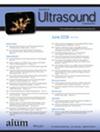Ultrasonographic Prevalence of Ring-Down Artifact in the Medial Elbow Joint Gap at the Valgus Position in Asymptomatic High School Baseball Players
Abstract
Objectives
Repetitive valgus stress during pitching in baseball can lead to medial elbow instability. Although ring-down artifact (RDA) has been considered an indicator of valgus instability, its pathological significance remains unclear. This study aimed to clarify RDA-positive rates and differences in valgus conditions in the medial elbow joint gap distance of asymptomatic high school baseball players.
Methods
Sixty-nine high-school students underwent ultrasonography to visualize the medial elbow joint gap distance. Individuals with linear hyperechoic images in the medial elbow joint gap distance were classified as RDA-positive, while those without were classified as RDA-negative. Measurements were conducted under three conditions: at rest (nongravity condition), with gravity-induced forearm valgus load (gravity condition), and with a ball grip in addition to the gravity condition (ball-grip condition). McNemar's test was conducted to compare changes in RDA-positive rates within each group under the three conditions for the pitching and nonpitching sides. The Student t test was conducted to compare medial elbow joint gap distance in RDA-positive and negative groups under the gravity condition.
Results
On the pitching side, RDA-positive rates significantly increased from 51.5% to 83.8% from nongravity condition to gravity condition and significantly decreased to 13.2% in ball-grip condition (P < .01). Similarly, on the nonpitching side, RDA-positive rates significantly increased from 44.1% to 55.9% between nongravity condition and gravity condition and significantly decreased to 14.7% in ball-grip condition (P < .01). RDA-positive rates were significantly higher on the pitching side than on the nonpitching side in gravity condition (P < .01). However, no significant differences were found in quantitative medial elbow joint gap distance between the RDA-positive (4.4 ± 0.9 mm) and RDA-negative groups (4.1 ± 0.9 mm) under gravity condition (P = .39).
Conclusion
RDA-positive rates in asymptomatic high school baseball players increased under gravity condition and decreased under ball-grip condition, but no significant difference was observed in quantitative medial elbow joint gap distance between RDA-positive and -negative groups. As such, RDA positivity may not be a specific indicator of valgus instability in gravity condition.


 求助内容:
求助内容: 应助结果提醒方式:
应助结果提醒方式:


